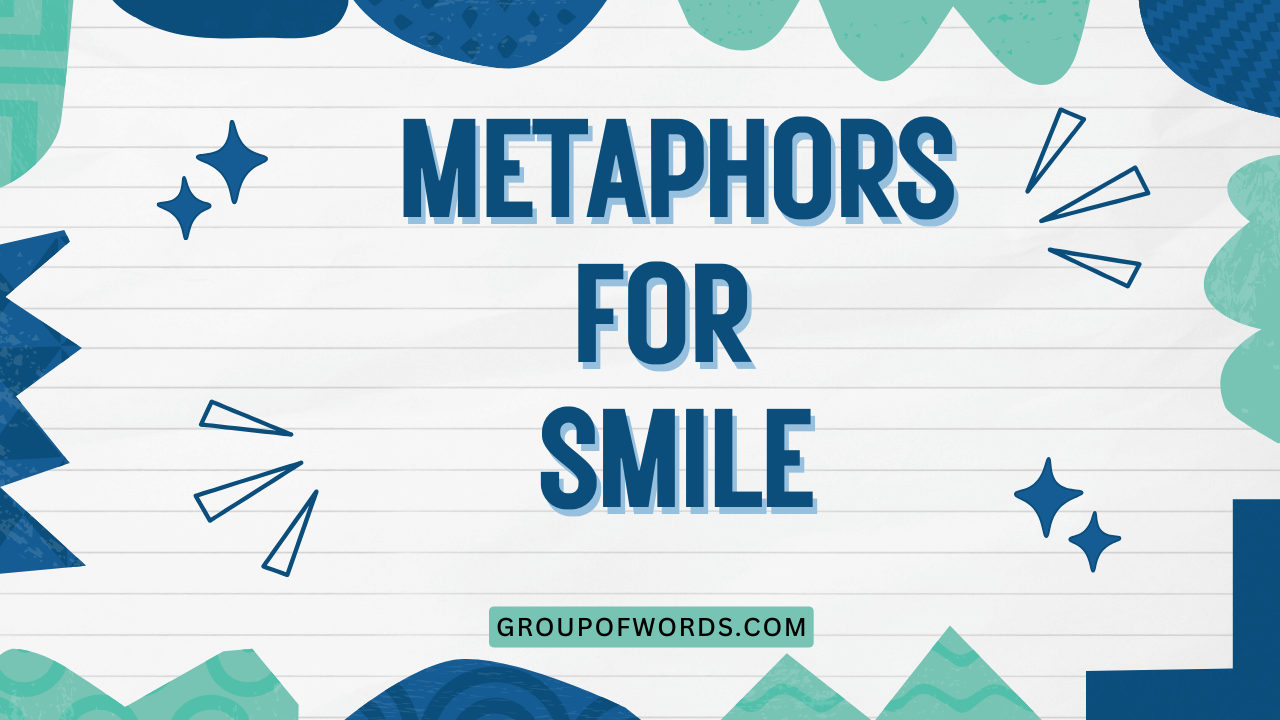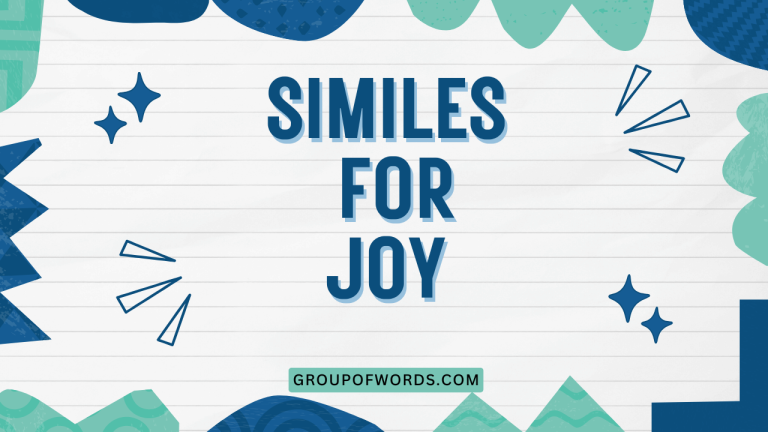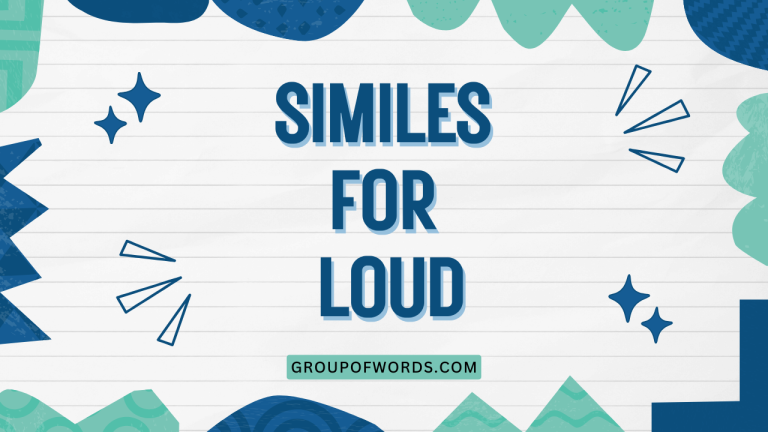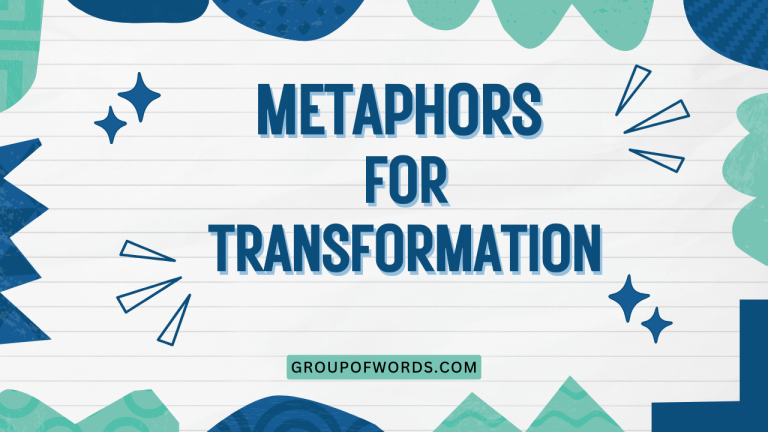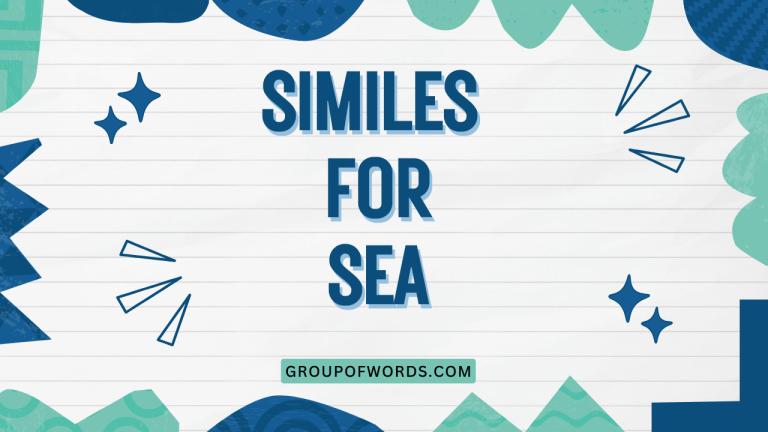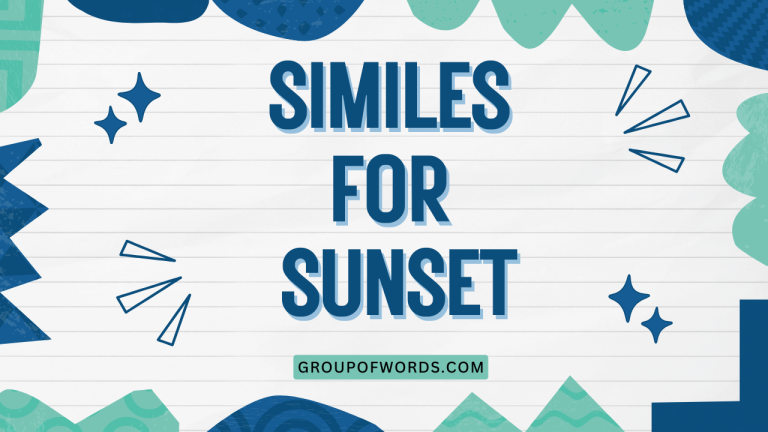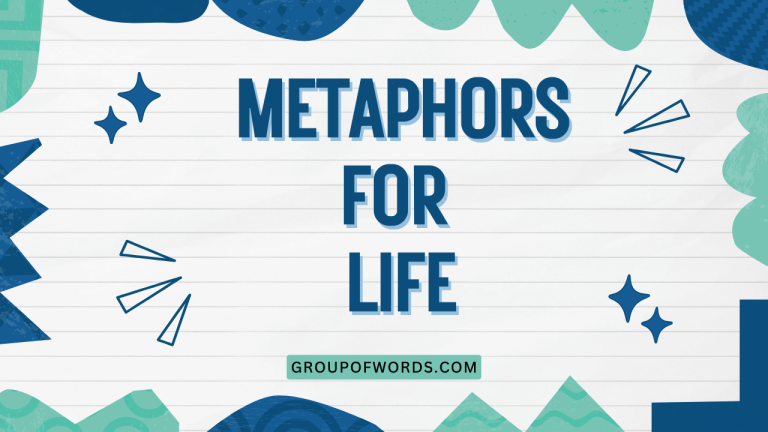Smiling Similes: Mastering Metaphors for Smiles
Understanding and using metaphors for smiles enriches your English vocabulary and enhances your ability to express emotions vividly. This article delves into the art of describing smiles through metaphorical language, exploring various types of smile metaphors, providing numerous examples, and offering practical exercises to improve your comprehension and usage.
Whether you’re an English language learner, a creative writer, or simply someone looking to refine their communication skills, this guide will equip you with the tools to paint compelling pictures of smiles with words.
This comprehensive guide is designed to provide a deep dive into metaphors for smiles, covering everything from their basic definition to advanced usage. By exploring different categories, analyzing examples, and practicing with tailored exercises, you’ll gain a solid understanding of how to effectively incorporate smile metaphors into your writing and speech.
Let’s embark on this linguistic journey and unlock the power of metaphorical expression.
Table of Contents
- Introduction
- Definition of Metaphor for Smile
- Structural Breakdown
- Types and Categories of Smile Metaphors
- Examples of Smile Metaphors
- Usage Rules
- Common Mistakes
- Practice Exercises
- Advanced Topics
- FAQ
- Conclusion
Definition of Metaphor for Smile
A metaphor for a smile is a figure of speech that directly compares a smile to something else, attributing qualities of that something else to the smile. Unlike similes, which use words like “like” or “as” to make a comparison, metaphors assert that the smile *is* something else.
This creates a more vivid and impactful image in the reader’s mind. Metaphors are used to add depth, emotion, and creativity to descriptions of smiles, making them more engaging and memorable.
The function of a smile metaphor is to convey the essence of a smile – its brightness, warmth, sincerity, or any other characteristic – by associating it with something familiar or evocative. This can help the reader or listener understand the smile on a deeper, more emotional level.
Consider the difference between saying “She had a bright smile” and “Her smile was sunshine.” The latter is far more evocative, painting a picture of warmth and radiance.
The context in which a smile metaphor is used also plays a crucial role. The appropriateness of a particular metaphor depends on the overall tone of the writing or conversation, as well as the specific characteristics of the smile being described.
A mischievous smile might be described as a “cat’s grin,” while a gentle smile might be likened to a “soft breeze.” Understanding these nuances is key to using smile metaphors effectively.
Structural Breakdown
The basic structure of a smile metaphor involves identifying the tenor (the smile itself) and the vehicle (the thing the smile is being compared to). The connection between the tenor and the vehicle is the ground – the shared characteristics or qualities that make the comparison meaningful. For example, in the metaphor “Her smile was a ray of sunshine,” the tenor is “her smile,” the vehicle is “a ray of sunshine,” and the ground is their shared quality of brightness and warmth.
Metaphors can be expressed in various grammatical forms. They can be simple noun phrases (e.g., “a sunbeam of a smile”), verb phrases (e.g., “her smile bloomed”), or even entire clauses (e.g., “her smile was the key that unlocked his heart”).
The choice of structure depends on the desired effect and the overall style of the writing.
Understanding the underlying structure of metaphors allows for more creative and effective use. By consciously considering the tenor, vehicle, and ground, you can craft metaphors that are both original and meaningful.
This analytical approach can also help in interpreting and appreciating the metaphors used by other writers and speakers.
Types and Categories of Smile Metaphors
Smile metaphors can be categorized based on the type of imagery they evoke. Here are some common categories:
Light-Related Metaphors
These metaphors compare smiles to sources of light, emphasizing their brightness, warmth, and radiance. They often convey feelings of happiness, hope, and positivity.
Examples include “sunshine,” “starlight,” “a beacon,” and “a spark.”
Nature-Related Metaphors
These metaphors draw comparisons between smiles and elements of nature, such as flowers, breezes, or landscapes. They often evoke feelings of serenity, growth, and natural beauty.
Examples include “a blooming flower,” “a gentle breeze,” “a sunrise,” and “a tranquil lake.”
Object-Related Metaphors
These metaphors compare smiles to inanimate objects, highlighting their shape, texture, or function. They can convey a range of emotions, from joy and amusement to irony or sarcasm.
Examples include “a crescent moon,” “a perfectly polished gem,” “a well-oiled machine,” and “a tightly wound spring.”
Animal-Related Metaphors
These metaphors associate smiles with the characteristics of animals, such as their expressions, movements, or sounds. They can convey playfulness, cunning, innocence, or other animalistic traits.
Examples include “a cat’s grin,” “a playful puppy’s wag,” “a sly fox’s smile,” and “a serene owl’s gaze.”
Emotion-Related Metaphors
These metaphors directly link smiles to specific emotions, emphasizing their connection to inner feelings and experiences. They can convey sincerity, warmth, vulnerability, or any other emotional quality.
Examples include “a smile of pure joy,” “a smile of understanding,” “a smile of forgiveness,” and “a smile of relief.”
Examples of Smile Metaphors
Here are some extensive examples of smile metaphors, organized by category, to illustrate the diverse ways in which smiles can be described metaphorically.
Light-Related Examples
Light-related metaphors are powerful tools for conveying the radiant and uplifting nature of a smile. These examples showcase how comparing a smile to light can evoke feelings of warmth, hope, and happiness.
The following table provides a variety of light-related metaphors for smiles, demonstrating the versatility of this category. Each example aims to create a vivid image of a smile’s brightness and its positive impact.
| Smile Metaphor | Example Sentence |
|---|---|
| Her smile was a ray of sunshine. | After the storm, her smile was a ray of sunshine, brightening everyone’s spirits. |
| His smile was pure sunlight. | His smile was pure sunlight, chasing away the shadows in her heart. |
| Her smile, a beacon in the night. | In the dimly lit room, her smile, a beacon in the night, guided him forward. |
| His smile was a spark. | His smile was a spark that ignited a flame of hope within her. |
| Her smile was a twinkling star. | Her smile was a twinkling star, captivating all who looked upon her. |
| His smile, a flash of lightning. | His smile, a flash of lightning, illuminated his face with sudden joy. |
| Her smile was a warm glow. | Her smile was a warm glow that made everyone feel comfortable. |
| His smile was a soft shimmer. | His smile was a soft shimmer, reflecting the happiness in his eyes. |
| Her smile was a radiant beam. | Her smile was a radiant beam, filling the room with positive energy. |
| His smile, a glimmer of hope. | His smile, a glimmer of hope, showed her that everything would be alright. |
| Her smile was a dancing flame. | Her smile was a dancing flame, flickering with amusement and delight. |
| His smile was a bright flare. | His smile was a bright flare, signaling his excitement and enthusiasm. |
| Her smile was a luminous glow. | Her smile was a luminous glow, emanating from her inner happiness. |
| His smile, a gentle candlelight. | His smile, a gentle candlelight, offered comfort and solace in the darkness. |
| Her smile was a brilliant flash. | Her smile was a brilliant flash, showcasing her intelligence and wit. |
| His smile was a golden ray. | His smile was a golden ray, warming her heart with its sincere affection. |
| Her smile was a gleaming spark. | Her smile was a gleaming spark, hinting at the mischief hidden within her. |
| His smile, a shining light. | His smile, a shining light, guided her through the complexities of life. |
| Her smile was a dazzling beam. | Her smile was a dazzling beam, captivating everyone with its sheer beauty. |
| His smile was a luminous spark. | His smile was a luminous spark, igniting passion and excitement in her soul. |
| Her smile was a sunburst. | Her smile was a sunburst, exploding with joy and vitality. |
| His smile, a moonbeam. | His smile, a moonbeam, soft and comforting in the quiet night. |
| Her smile was a firefly’s gleam. | Her smile was a firefly’s gleam, subtle yet enchanting in the twilight. |
| His smile was a spotlight. | His smile was a spotlight, drawing attention to his genuine enthusiasm. |
Nature-Related Examples
Nature-related metaphors evoke images of serenity, growth, and natural beauty. By comparing a smile to elements of nature, we can convey its organic and harmonious qualities.
The following table presents a diverse collection of nature-related metaphors for smiles. These examples aim to illustrate how a smile can be likened to the beauty and tranquility found in the natural world.
| Smile Metaphor | Example Sentence |
|---|---|
| Her smile was a blooming flower. | Her smile was a blooming flower, unfolding with grace and beauty. |
| His smile was a gentle breeze. | His smile was a gentle breeze, soothing her troubled mind. |
| Her smile was a sunrise. | Her smile was a sunrise, promising a new beginning. |
| His smile was a tranquil lake. | His smile was a tranquil lake, reflecting peace and serenity. |
| Her smile was a field of daisies. | Her smile was a field of daisies, cheerful and bright. |
| His smile was a forest stream. | His smile was a forest stream, refreshing and revitalizing. |
| Her smile was a mountain peak. | Her smile was a mountain peak, strong and unwavering. |
| His smile was a rolling hill. | His smile was a rolling hill, inviting and comforting. |
| Her smile was a lush meadow. | Her smile was a lush meadow, vibrant and full of life. |
| His smile was a desert oasis. | His smile was a desert oasis, a welcome relief in a barren land. |
| Her smile was a vine of ivy. | Her smile was a vine of ivy, gently wrapping around his heart. |
| His smile was a towering tree. | His smile was a towering tree, providing shelter and strength. |
| Her smile was a garden of roses. | Her smile was a garden of roses, filled with love and beauty. |
| His smile was a babbling brook. | His smile was a babbling brook, a constant source of joy. |
| Her smile was a snow-capped mountain. | Her smile was a snow-capped mountain, majestic and pure. |
| His smile was a sandy beach. | His smile was a sandy beach, warm and inviting. |
| Her smile was a starry night. | Her smile was a starry night, full of wonder and magic. |
| His smile was a sun-kissed leaf. | His smile was a sun-kissed leaf, delicate and beautiful. |
| Her smile was a calm ocean. | Her smile was a calm ocean, vast and serene. |
| His smile was a gentle rain. | His smile was a gentle rain, washing away all his worries. |
| Her smile was a rainbow. | Her smile was a rainbow, promising hope after the storm. |
| His smile was a maple leaf. | His smile was a maple leaf, colorful and comforting in the fall. |
| Her smile was a cherry blossom. | Her smile was a cherry blossom, delicate and fleetingly beautiful. |
| His smile was a willow tree. | His smile was a willow tree, graceful and resilient. |
Object-Related Examples
Object-related metaphors use inanimate objects to describe a smile, highlighting its shape, texture, or function. These metaphors can convey a wide range of emotions, from joy and amusement to irony or sarcasm.
The following table provides several object-related metaphors for smiles, demonstrating how comparing a smile to an object can add depth and nuance to its description.
| Smile Metaphor | Example Sentence |
|---|---|
| Her smile was a crescent moon. | Her smile was a crescent moon, a sliver of happiness in the night. |
| His smile was a perfectly polished gem. | His smile was a perfectly polished gem, reflecting his inner brilliance. |
| Her smile was a well-oiled machine. | Her smile was a well-oiled machine, smooth and effortless. |
| His smile was a tightly wound spring. | His smile was a tightly wound spring, ready to burst with joy. |
| Her smile was a fragile glass. | Her smile was a fragile glass, beautiful but easily broken. |
| His smile was an iron gate. | His smile was an iron gate, guarding his true emotions. |
| Her smile was a silk scarf. | Her smile was a silk scarf, soft and luxurious. |
| His smile was a steel trap. | His smile was a steel trap, hiding his cunning intentions. |
| Her smile was a porcelain doll. | Her smile was a porcelain doll, delicate and artificial. |
| His smile was a wooden mask. | His smile was a wooden mask, concealing his true feelings. |
| Her smile was a velvet curtain. | Her smile was a velvet curtain, hiding a world of secrets. |
| His smile was a stone wall. | His smile was a stone wall, impenetrable and unyielding. |
| Her smile was a silver bell. | Her smile was a silver bell, clear and musical. |
| His smile was a golden key. | His smile was a golden key, unlocking her heart. |
| Her smile was a paper crane. | Her smile was a paper crane, delicate and hopeful. |
| His smile was a rusty hinge. | His smile was a rusty hinge, awkward and forced. |
| Her smile was a crystal chandelier. | Her smile was a crystal chandelier, extravagant and dazzling. |
| His smile was a worn leather. | His smile was a worn leather, comfortable and familiar. |
| Her smile was a spinning top. | Her smile was a spinning top, dizzying and unpredictable. |
| His smile was a broken mirror. | His smile was a broken mirror, reflecting his shattered soul. |
| Her smile was a ticking clock. | Her smile was a ticking clock, a reminder of the time slipping away. |
| His smile was a loaded gun. | His smile was a loaded gun, dangerous and unpredictable. |
| Her smile was a closed book. | Her smile was a closed book, hiding a wealth of knowledge and experience. |
| His smile was a blank canvas. | His smile was a blank canvas, full of potential and possibility. |
Animal-Related Examples
Animal-related metaphors draw comparisons between smiles and the characteristics of animals, such as their expressions, movements, or sounds. These metaphors can convey playfulness, cunning, innocence, or other animalistic traits.
The following table showcases various animal-related metaphors for smiles, illustrating how associating a smile with an animal can add a unique and evocative dimension to its description.
| Smile Metaphor | Example Sentence |
|---|---|
| Her smile was a cat’s grin. | Her smile was a cat’s grin, hinting at mischief. |
| His smile was a playful puppy’s wag. | His smile was a playful puppy’s wag, full of joy. |
| Her smile was a sly fox’s smile. | Her smile was a sly fox’s smile, suggesting cunning. |
| His smile was a serene owl’s gaze. | His smile was a serene owl’s gaze, wise and knowing. |
| Her smile was a bird’s chirp. | Her smile was a bird’s chirp, light and musical. |
| His smile was a lion’s roar. | His smile was a lion’s roar, confident and powerful. |
| Her smile was a butterfly’s flutter. | Her smile was a butterfly’s flutter, delicate and fleeting. |
| His smile was a snake’s slither. | His smile was a snake’s slither, deceptive and unsettling. |
| Her smile was a lamb’s bleat. | Her smile was a lamb’s bleat, innocent and pure. |
| His smile was a wolf’s snarl. | His smile was a wolf’s snarl, menacing and aggressive. |
| Her smile was a kitten’s purr. | Her smile was a kitten’s purr, content and comforting. |
| His smile was a bear’s growl. | His smile was a bear’s growl, intimidating and protective. |
| Her smile was a dove’s coo. | Her smile was a dove’s coo, peaceful and gentle. |
| His smile was a hawk’s swoop. | His smile was a hawk’s swoop, focused and intense. |
| Her smile was a fish’s gulp. | Her smile was a fish’s gulp, awkward and out of place. |
| His smile was a horse’s whinny. | His smile was a horse’s whinny, free and spirited. |
| Her smile was a peacock’s display. | Her smile was a peacock’s display, proud and showy. |
| His smile was a turtle’s retreat. | His smile was a turtle’s retreat, slow and cautious. |
| Her smile was a swan’s glide. | Her smile was a swan’s glide, graceful and elegant. |
| His smile was a tiger’s stalk. | His smile was a tiger’s stalk, calculated and predatory. |
| Her smile was a ladybug’s crawl. | Her smile was a ladybug’s crawl, small and endearing. |
| His smile was a parrot’s mimic. | His smile was a parrot’s mimic, insincere and repetitive. |
| Her smile was a bee’s buzz. | Her smile was a bee’s buzz, busy and energetic. |
| His smile was a cricket’s chirp. | His smile was a cricket’s chirp, constant and comforting in the night. |
Emotion-Related Examples
Emotion-related metaphors directly link smiles to specific emotions, emphasizing their connection to inner feelings and experiences. These metaphors can convey sincerity, warmth, vulnerability, or any other emotional quality.
The following table provides a variety of emotion-related metaphors for smiles, demonstrating how a smile can be described in terms of the feelings it expresses or evokes.
| Smile Metaphor | Example Sentence |
|---|---|
| Her smile was a smile of pure joy. | Her smile was a smile of pure joy, radiating happiness. |
| His smile was a smile of understanding. | His smile was a smile of understanding, showing empathy. |
| Her smile was a smile of forgiveness. | Her smile was a smile of forgiveness, offering reconciliation. |
| His smile was a smile of relief. | His smile was a smile of relief, washing away his worries. |
| Her smile was a smile of gratitude. | Her smile was a smile of gratitude, expressing thankfulness. |
| His smile was a smile of sadness. | His smile was a smile of sadness, masking his inner pain. |
| Her smile was a smile of hope. | Her smile was a smile of hope, promising a brighter future. |
| His smile was a smile of longing. | His smile was a smile of longing, yearning for what was lost. |
| Her smile was a smile of amusement. | Her smile was a smile of amusement, reflecting her playful nature. |
| His smile was a smile of confidence. | His smile was a smile of confidence, projecting strength and assurance. |
| Her smile was a smile of vulnerability. | Her smile was a smile of vulnerability, showing her true self. |
| His smile was a smile of defiance. | His smile was a smile of defiance, challenging the status quo. |
| Her smile was a smile of peace. | Her smile was a smile of peace, radiating tranquility. |
| His smile was a smile of resignation. | His smile was a smile of resignation, accepting his fate. |
| Her smile was a smile of warmth. | Her smile was a smile of warmth, making everyone feel welcome. |
| His smile was a smile of irony. | His smile was a smile of irony, masking his true intentions. |
| Her smile was a smile of anticipation. | Her smile was a smile of anticipation, eagerly awaiting the future. |
| His smile was a smile of nostalgia. | His smile was a smile of nostalgia, reminiscing about the past. |
| Her smile was a smile of comfort. | Her smile was a smile of comfort, offering solace to those in need. |
| His smile was a smile of understanding. | His smile was a smile of understanding, acknowledging her pain. |
| Her smile was a smile of pure delight. | Her smile was a smile of pure delight, expressing unadulterated happiness. |
| His smile was a smile of cautious optimism. | His smile was a smile of cautious optimism, tempered by past experiences. |
| Her smile was a smile of quiet satisfaction. | Her smile was a smile of quiet satisfaction, content with her accomplishments. |
| His smile was a smile of mischievous glee. | His smile was a smile of mischievous glee, plotting his next adventure. |
Usage Rules
When using metaphors for smiles, it’s important to ensure that the comparison is both meaningful and appropriate for the context. Here are some key rules to follow:
- Clarity: The metaphor should be easily understood. Avoid obscure or overly complex comparisons that might confuse the reader. The ground between the tenor (smile) and the vehicle (the thing being compared to) should be readily apparent.
- Relevance: The metaphor should be relevant to the specific characteristics of the smile being described. Consider the emotion, intensity, and overall impression you want to convey.
- Originality: While common metaphors can be effective, strive for originality to make your writing more engaging and memorable. Think outside the box and explore unexpected comparisons.
- Consistency: Maintain consistency in your metaphorical language. Avoid mixing metaphors that clash or create conflicting images.
- Context: The appropriateness of a metaphor depends on the overall tone and style of the writing or conversation. A lighthearted metaphor might be suitable for a casual setting, while a more serious metaphor might be required for a formal context.
Exceptions and Special Cases: Sometimes, breaking the rules can lead to creative and effective metaphors. For example, deliberately mixing metaphors can create a humorous or surreal effect. However, this should be done intentionally and with careful consideration of the overall impact.
Common Mistakes
Several common mistakes can undermine the effectiveness of smile metaphors. Being aware of these pitfalls can help you avoid them and create more compelling descriptions.
The following table highlights some common mistakes in using metaphors for smiles and provides corrected examples to illustrate the proper usage.
| Mistake | Incorrect Example | Corrected Example |
|---|---|---|
| Clichéd Metaphor: Using overused or predictable metaphors. | Her smile was as bright as the sun. | Her smile was a sunrise, promising a new beginning. |
| Mixed Metaphor: Combining metaphors that create conflicting images. | His smile was a beacon of hope that sailed through the forest. | His smile was a beacon of hope, guiding her through the darkness. |
| Inappropriate Metaphor: Using a metaphor that is not suitable for the context or the emotion being conveyed. | Her smile was a steel trap, full of joy. | Her smile was a burst of sunshine, full of joy. |
| Obscure Metaphor: Using a metaphor that is difficult to understand or interpret. | His smile was a quantum entanglement. | His smile was a gentle breeze, soothing her troubled mind. |
| Redundant Metaphor: Using a metaphor that simply repeats the obvious. | Her smile was a happy smile. | Her smile was a blooming flower, radiating happiness. |
| Literal Interpretation: Using a metaphor that is taken too literally, losing its figurative meaning. | His smile was a golden key, but he didn’t unlock anything. | His smile was a golden key, unlocking her heart. |
Practice Exercises
These exercises are designed to help you practice identifying, completing, and creating metaphors for smiles. Working through these exercises will enhance your understanding and application of this important grammatical concept.
Exercise 1: Identifying Metaphors
Identify the metaphor for “smile” in each
of the following sentences and explain what qualities of the smile it emphasizes.
- Her smile was a warm blanket on a cold day.
- His smile was a mischievous glint in his eyes.
- Her smile was a gentle wave washing over him.
- His smile was a tightly guarded secret.
- Her smile was a beacon in the darkness.
Exercise 2: Completing the Metaphor
Complete the following sentences by adding an appropriate metaphor for “smile.” Explain your choice.
- His smile was like ______, filling the room with warmth.
- Her smile, a ______ , hinted at the secrets she held.
- His smile was ______, bright and infectious.
- Her smile was ______, a subtle sign of her inner peace.
- His smile, ______, revealed his genuine happiness.
Exercise 3: Creating Your Own Metaphors
Create your own original metaphors for “smile” based on the following prompts. Try to use a variety of categories (light, nature, object, animal, emotion).
- Describe a smile that conveys deep sadness.
- Describe a smile that shows mischievous intent.
- Describe a smile that expresses pure joy.
- Describe a smile that offers comfort and reassurance.
- Describe a smile that is mysterious and enigmatic.
Advanced Topics
For those looking to delve deeper into the art of using metaphors for smiles, here are some advanced topics to explore:
- Extended Metaphors: Developing a single metaphor over multiple sentences or paragraphs to create a richer, more complex image.
- Subverted Metaphors: Using metaphors in unexpected or ironic ways to challenge conventional expectations.
- Cross-Modal Metaphors: Combining sensory experiences (e.g., visual and auditory) to create unique and evocative metaphors.
- Cultural Variations: Exploring how metaphors for smiles differ across cultures and languages.
- Metaphor and Symbolism: Understanding the symbolic meaning of different metaphors and how they can be used to convey deeper themes and ideas.
FAQ
What is the difference between a simile and a metaphor?
A simile uses “like” or “as” to compare two things, while a metaphor directly equates them without using those words. For example, “Her smile was like sunshine” is a simile, while “Her smile was sunshine” is a metaphor.
How can I make my metaphors more original?
Think beyond the obvious comparisons. Consider unusual or unexpected connections between the smile and the thing you’re comparing it to.
Explore different categories of imagery (light, nature, objects, animals, emotions) to find fresh perspectives.
Is it okay to use clichés in my writing?
While clichés can be easily understood, they often lack impact and originality. It’s generally best to avoid them and strive for more creative and evocative language.
However, clichés can be used intentionally for specific effects, such as humor or irony.
How do I know if a metaphor is appropriate for the context?
Consider the overall tone and style of your writing or conversation. A lighthearted metaphor might be suitable for a casual setting, while a more serious or formal context might require a different approach.
Also, think about the specific characteristics of the smile you’re describing and choose a metaphor that aligns with those qualities.
Can I mix metaphors in my writing?
Mixing metaphors can create confusing or contradictory images. It’s generally best to avoid mixing metaphors unless you’re doing it intentionally for a specific effect, such as humor or surrealism.
If you do mix metaphors, be sure to do it carefully and with a clear understanding of the potential impact.
Conclusion
Mastering the art of using metaphors for smiles can significantly enhance your writing and communication skills. By understanding the different types of smile metaphors, following usage rules, avoiding common mistakes, and practicing with tailored exercises, you can effectively convey the nuances and emotions associated with smiles.
Embrace the power of metaphorical language and unlock new dimensions of expression in your writing and speech. Keep practicing, experimenting, and refining your skills, and you’ll be well on your way to becoming a master of smile metaphors.
